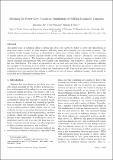Breaking the power law: Multiscale simulations of self-ion irradiated tungsten
Author(s)
Jin, Miaomiao; Permann, Cody; Short, Michael P.
DownloadMain article after revisions (2.394Mb)
Terms of use
Metadata
Show full item recordAbstract
The initial stage of radiation defect creation has often been shown to follow a power law distribution at short time scales, recently so with tungsten, following many self-organizing patterns found in nature. The evolution of this damage, however, is dominated by interactions between defect clusters, as the coalescence of smaller defects into clusters depends on the balance between transport, absorption, and emission to/from existing clusters. The long-time evolution of radiation-induced defects in tungsten is studied with cluster dynamics parameterized with lower length scale simulations, and is shown to deviate from a power law size distribution. The effects of parameters such as dose rate and total dose, as parameters affecting the strength of the driving force for defect evolution, are also analyzed. Excellent agreement is achieved with regards to an experimentally measured defect size distribution at 30 K. This study provides another satisfactory explanation for experimental observations in addition to that of primary radiation damage, which should be reconciled with additional validation data.
Date issued
2018-06Department
Massachusetts Institute of Technology. Department of Nuclear Science and EngineeringJournal
Journal of Nuclear Materials
Publisher
Elsevier BV
Citation
Jin, Miaomiao et al. "Breaking the power law: Multiscale simulations of self-ion irradiated tungsten." Journal of Nuclear Materials 504 (June 2018): 33-40 © 2018 Elsevier B.V.
Version: Author's final manuscript
ISSN
0022-3115
Collections
The following license files are associated with this item: